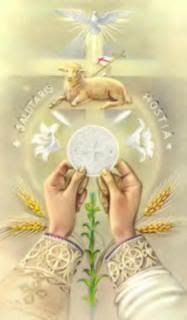I often see people asking about the pre Vatican II fasting guidelines on discussion forums. From the New Marian Missal, published by Angelus Press, here they are for the US:
"Abstinence: All Catholics seven years and older are obliged to observe the Law of Abstinence.
On days of complete abstinence flesh meat, soup or gravy made from meat are not permitted at all. On days of partial abstinence flesh meat, soup or gravy made from meat ar permitted once a day at the principal meal.
Complete abstinence is to be observed on all Fridays of the year, Ash Wednesday, Vigils of the Immaculate Conception and Christmas, and on Holy Saturday. Partial abstinence is to be observed on Ember Wednesdays and Saturdays, and on the Vigil of Pentecost.
Fasting: All Catholics from the completion of their twenty-first year to the beginning of their sixtieth year are bound to observe the Law of fast. The days of fast are the weekdays of Lent, Ember Days, the Vigils of Pentecost, the Immaculate Conception, Christmas. Only one full meal is allowed on a day of Fast. Two other meatless meals are permitted. These meals should be sufficient to maintain strength in accordance with each one's needs. Both of these meals, or collations, together, should not equal one full meal.
It is permissible to eat meat at the principle meal on a Fast Day except on Fridays, Ash Wednesday, and the Vigils of Immaculate Conception, Christmas, and Holy Saturday.
Solid foods between meals is not permitted. Liquids, including coffee, tea, milk and fruit juices are allowed.
In connection with problems arising from the Laws of Fast and Abstinence, a confessor or priest should be consulted. Dispensations may be granted for a serious reason concerning health or the ability to work."
For Canada, the guidelines read:
"Fasting Days: All days in Lent, except Sundays, the Ember Days, the Vigils of Whitsunday, of All Saints, of the Immaculate Conception and of Christmas Day.
Abstinence Days: The Ember Days, the Vigils mentioned above, the
Wednesdays of Lent, Holy Saturdays forenoon, and all Fridays, except Days of Obligation."
Now, who can tell me what Whitsunday and Ember Days are, and what happened to them?
Tuesday, February 19, 2008
Subscribe to:
Post Comments (Atom)













6 comments:
Here's what I found on Ember Days:
Three days set apart for fasting, abstinence, and prayer during each of the four seasons of the year. They were the Wednesday, Friday, and Saturday after St. Lucy (d. 304) (December 13), the First Sunday of Lent, Pentecost, and the feast of the Holy Cross (September 14). Since the revision of the Roman calendar in 1969, Ember Days are to be observed at the discretion of the National Conferences of Bishops. Moreover, their observance may be extended beyond three days and even repeated during the year. Possibly occasioned by the agricultural feast of ancient Rome, they came to be observed by Christians for the sanctification of the different seasons of the year, and for obtaining God's blessing on the clergy to be ordained during the Embertides.
Thanks, Shirley. I guess our bishops find Ember Days too distasteful to the modern Catholic, to bother with implementing them anymore. It's hard enough to get people to comply with abstinence on Fridays; how could they possibly add an extra 12 days a year for fasting, prayer and abstinence?
*sarcasm intended*
the pre V2 guideline for fasting are good.
They (the hierarchy) would rather us not BE "Catholics", nor would they.
When I was on the way back to the Church back in '97, I met with the local priest. This guy was so stereotypically gay that you'd almost think he was fooling with you. Anyway, this queen told me "well we try not to be TOO Catholic" around here.
I've always wondered just what the heck that meant. Of course, being back for 10 years, I know all too well what that means.
Shirley gave a pretty full answer...Whitsunday is another name for Pentecost. I was explaining the Ember Days to a friend recently and she suggested that they had pagan elements because of the seasons. Now how's that for a novus ordo interpretation! It was that same "antiquarianism" that smashed statures because they might encourage "idolatry" and now we stand for communion because we're all grown up and that's what they did in the early church---as Father Groescel would say..."and you were there?"
All these great liturgical observances were stripped away from us after the Council with the adaption of the new calendar. It is really unfortunate even that here in Canada we only have two Holy Days of Obligation being Christmas and Solemnity of Mary, Mother of God which should never have been changed from the Feast of the Circumcision of Our LORD.
What is interesting though are the fast guidelines regardless of days. In illo tempore the communion fast was also three hours (reduced by Piux XII from midnight). But these things are governed by Canon Law not liturgical norms. Therefore, it is lawful under Canon Law to attend an Extraordinary Form Mass on an Ember Day and follow the current fasting guidelines which are slightly different from what is printed in the Angelus Missal (SSPX publisher). These are Traditional fasts but not mandatory--Canon Law trumps Tradition--which is a whole other debate, of course.
I LOVE your concise summation of the earlier fasting rules. I hope you don't mind if I link to them for my Lent 2013 Challenge to live by these rules?
Post a Comment